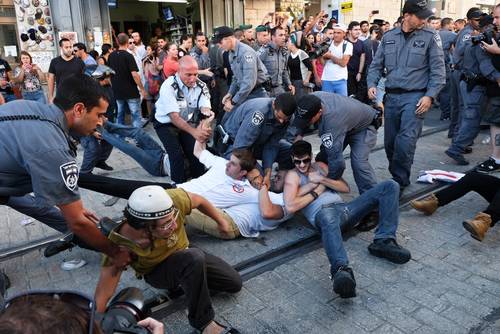
Israeli society prides itself on its openness; the self-image of coexistence and tolerance is a key element of the democratic Jewish state. Israeli spokespersons like to compare Israel to the intolerance that, they say, has swept the region. However, events in the summer of 2014 have challenged the claim of coexistence and tolerance, as Israeli society confronts a wave of anti-Arab incitement.
The story begins with the kidnapping and murder of three Jewish settlers in June 2014. The abduction sparked a wave of public solidarity protests and prayer rallies until the three were found dead in a field near Hebron on 30 June. Condemning the brutal murder, Prime Minister Binyamin Netanyahu returned to a favorite theme: The incident demonstrated the “broad moral gulf (that) separates us from our enemies,” he said. “They sanctify death; we sanctify life,” he continued. “They sanctify cruelty, and we mercy and compassion. That is the secret of our strength.”
Within days, the “broad moral gulf” was narrowed. On the morning of 2 July, as Israelis headed to work, initial reports came of a Palestinian teen, Muhammad Abu Khdeir, murdered in East Jerusalem. It soon emerged that the killers were Jews, that their motive was nationalist, and that their aim was revenge for killing the three Jewish teens weeks earlier.
Confronted with the murder, a shellshocked Israel entered a period of soul-searching. Knesset members across the political spectrum condemned the killing. Busloads of Israelis made their way to the Abu Khdeir home to comfort the mourners. Yet, opinion leaders wondered if the society had been too tolerant of anti-Arab rhetoric over the years. Even in the days before the Abu Khdeir killing, users had bragged on social media of their hate for Arabs and had even set up pages trumpeting their bigotry. How had this come about? Had Israeli society been so awash in self-praise about its tolerance and openness that it had ignored the worrying signs?
Commentators fretted about potential consequences: Protests turned violent in Palestinian neighborhoods of Jerusalem. Demonstrations spread to Arab-populated areas inside the Green Line. Authorities feared widening confrontations. The military operation in Gaza threatened to inflame tensions further.
And then the issue disappeared. Protests inside the Green Line dissipated. Jerusalem’s light-rail system still sees some disruption in service by Palestinian stone-throwers, but in Jerusalem, too, tensions have calmed. Credit for this goes largely to the local authorities in Arab towns and villages who quietly but diligently worked to bring calm in the establishment’s view.
The calm threatens to push underlying questions—including that of anti-Arab incitement—off the public agenda. Instead, with internal Jewish-Arab tensions off the front burner, public attention has moved on to the ongoing Gaza standoff, the perpetual fight over the defense budget, and, as in the rest of the Middle East, the specter of ISIS and other jihadist groups in neighboring Syria.
In that sense, key questions remain unaddressed: Should the Knesset enact stronger legislation against hate speech? How should the government tackle unequal funding of Arab education systems and other social services? How can both the government and private sector increase the opportunities for Israel’s Arabs in the lucrative high-tech sector?
Most importantly, in what way can society strengthen the norms against anti-Arab incitement? When the news of Abu Khdeir’s murder first broke, many instinctively pointed the finger at the long side curls of the “hilltop youth,” teenage or twenty-something settlers with extreme political views. Though, the actual culprits in the murder were not youths from distant Samarian hilltops but a group somewhat closer to the Israeli mainstream: rabid fans of the Beitar Jerusalem soccer team.
The connection with the Beitar club poses a challenge. For years, fans of this club were known for their racist expressions towards Arabs, which the public did not take very seriously. In the wake of the Abu Khdeir murder, the question is whether social attitudes will change. What happens in the upcoming season? When fans break into anti-Arab chants, how does the league—and the broader public—react?
Anti-Arab incitement flourishes in Israeli subcultures, but the fear is that it has begun to seep into the mainstream. For Israelis, this presents yet another challenge. Since the social-protest movement of 2011, many realized that internal cleavages pose a threat as great or greater than external foes. As a result, attention has focused on gaps between haredi and secular, between center and periphery, between the tycoons and self-made millionaires of the “start-up nation” and a stagnant middle class.
The summer of 2014 provided a reminder—and a warning—of the fragility of the relationship between Arab and Jew. For now, the issue may have receded to the margins of an always-crowded public agenda, but, left unanswered, the echoes of the summer’s incitement can haunt society, and the embers of anger may be ignited anew.


